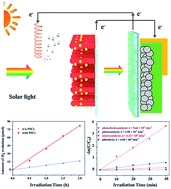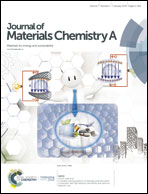Enabling highly efficient photocatalytic hydrogen generation and organics degradation via a perovskite solar cell-assisted semiconducting nanocomposite photoanode†
Abstract
Organometal trihalide perovskite solar cells (PSCs) have been widely recognized as a promising photovoltaic device due to their impressive set of outstanding excellent optoelectronic properties. However, the instability and intermittent energy output caused by the intensity fluctuation and/or the daily cycle of sunlight have motivated the direct application of PSCs in other energy fields. Here, we report an integrated solar-energy-conversion/water-splitting device comprising a single-junction PSC and CdS-decorated TiO2 nanorod array (i.e., semiconducting CdS/TiO2 NRA nanocomposite) photoanode with excellent photoelectrochemical (PEC) performance. Intriguingly, the introduction of PSC is found to effectively suppress the recombination of electrons and holes during the PEC catalytic process. As a result, the integrated device yields an overall solar-to-hydrogen efficiency of 1.54% and exhibits a six-fold increase in the degradation rate of methylene blue over that of the CdS/TiO2 NRAs alone. As such, the crafting of a perovskite solar cell-assisted nanocomposite semiconductor photoanode may represent a viable route to alleviating the electron–hole recombination in water splitting and the degradation of organic pollutants, thus rendering the effective implementation of PSCs.



 Please wait while we load your content...
Please wait while we load your content...